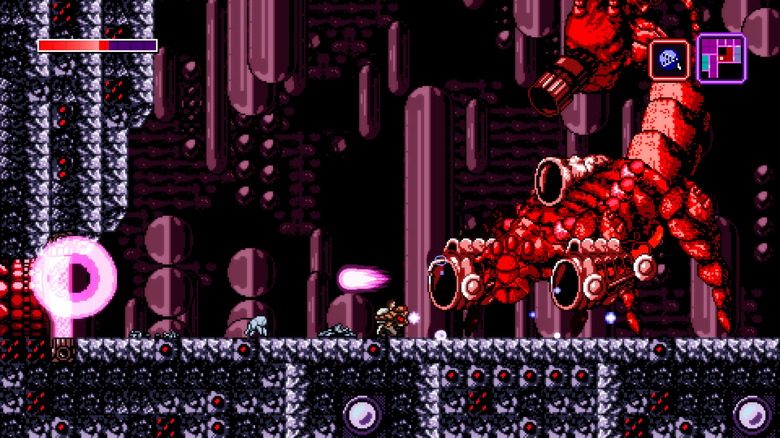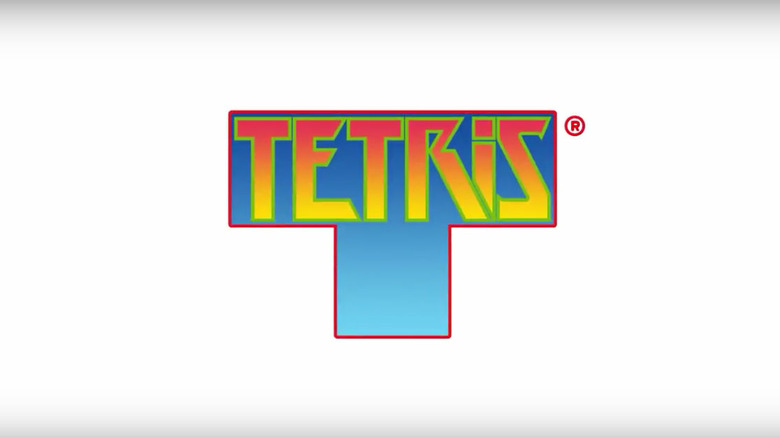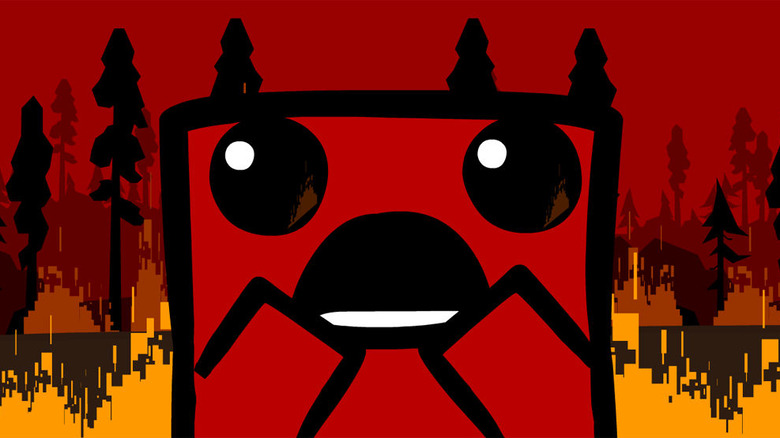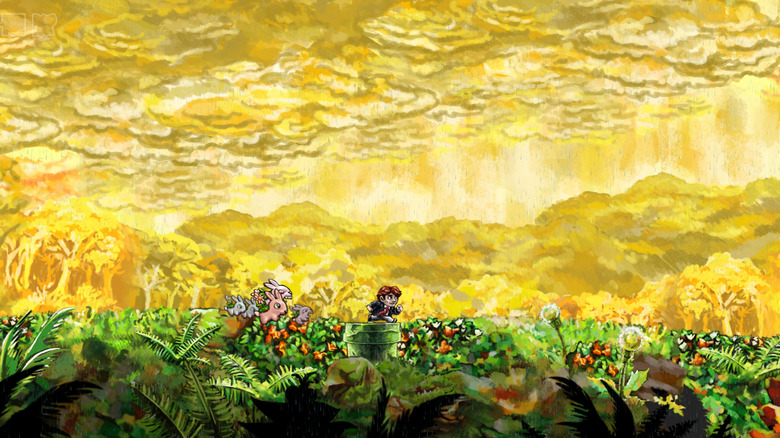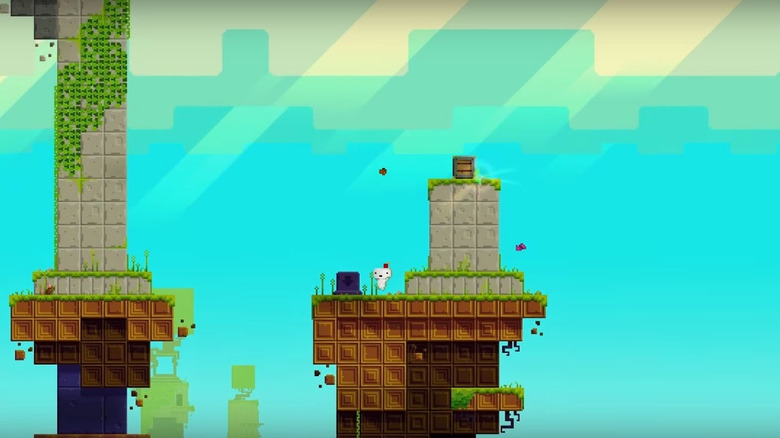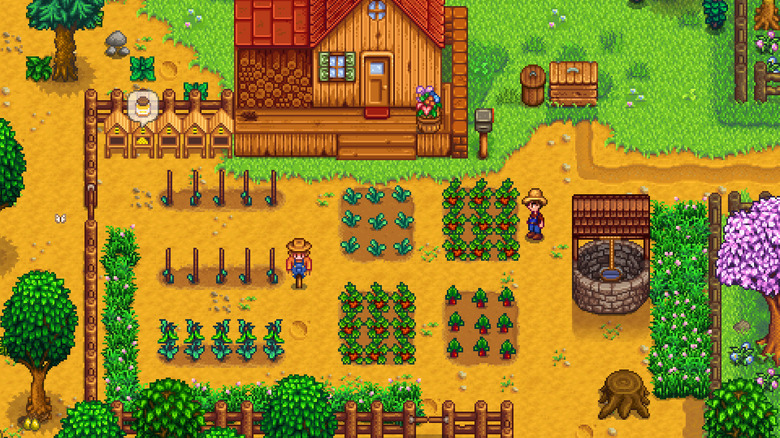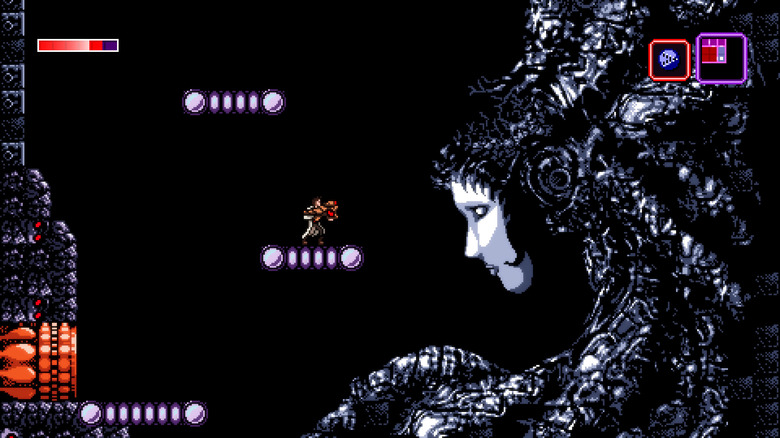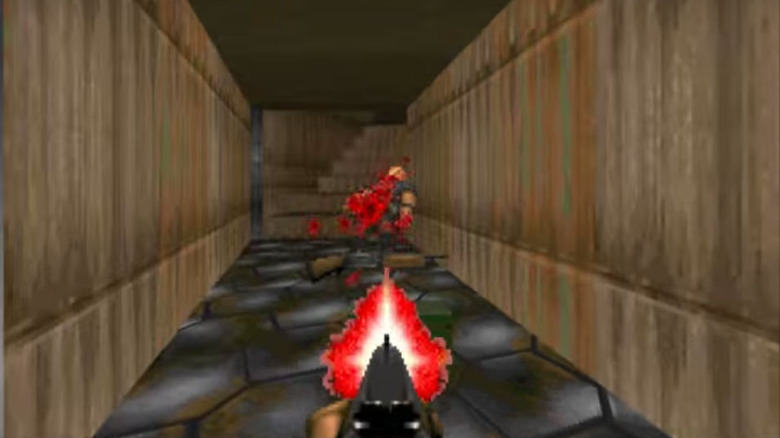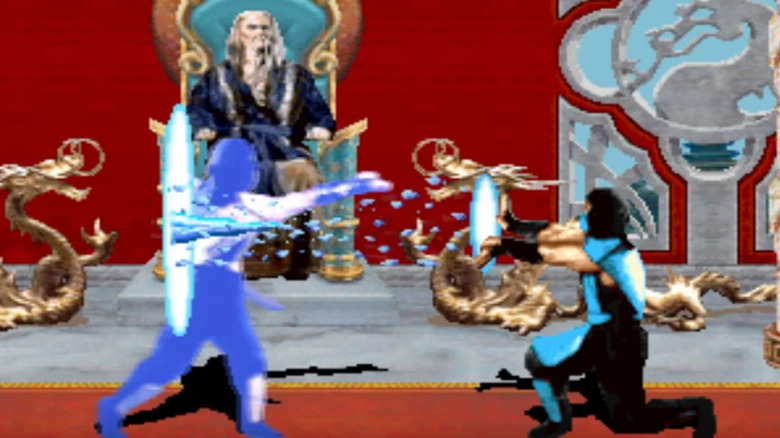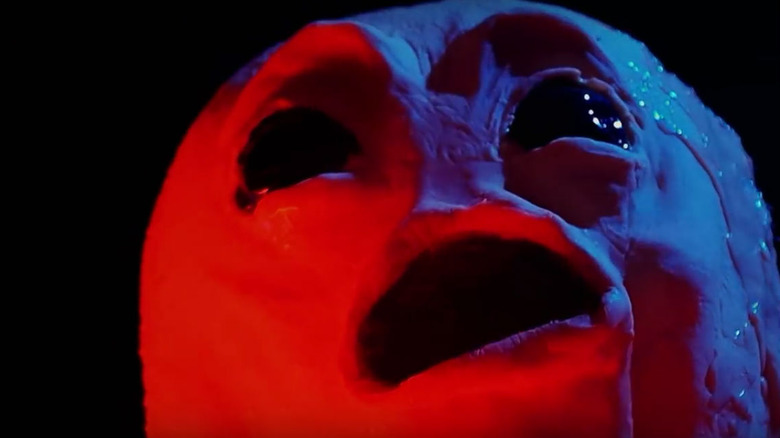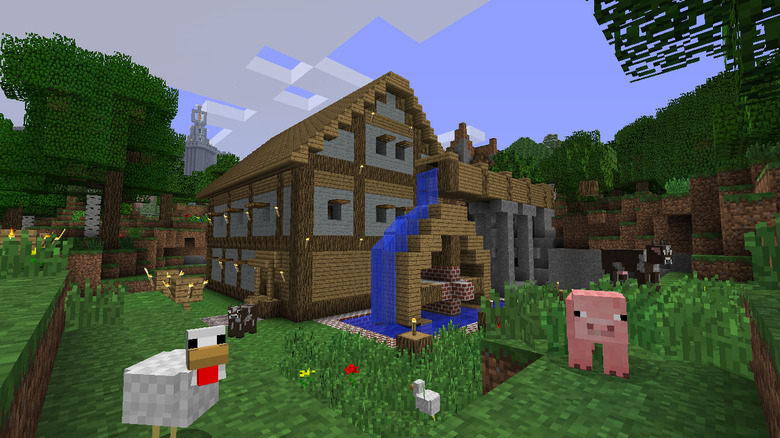Awesome Games Created By Very Few People
It may very well have been the 2012 Sundance Award-winning documentary film, Indie Game: The Movie, that hammered in the idea that games are made by real people. If you mostly play AAA blockbusters made by Electronic Arts or Activision or Bethesda, it's easy to imagine that all game companies count on the support of dozens (and sometimes hundreds) of employees to put out a good product.
But that's not always the case. In fact, the stories behind some of the most well-known games — both classic and modern — involve very few people. One of the most popular games in the world, Tetris, was designed by exactly ONE person (although he didn't make any money off the game until the mid-90s). Minecraft, the beloved sandbox game, has a similar story.
And there are a plethora of indie games that went on to see massive success despite the fact that they were built off the backs and hopes of very small teams. Here are ten examples of tiny development teams that went on to achieve greatness!
In a land of Communism, Tetris was an individual achievement
The story of the making of Tetris is a long and complicated one. It was created by Russian computer programmer Alexey Pajitnov in 1984 while working at the Academy of Science of the USSR, where he was researching artificial intelligence. Pajitnov, who regularly wrote computer programs to test the capabilities of new hardware, designed Tetris on an Electronika 60 computer.
Pajitnov told The Guardian that he was inspired by pentominos puzzles — a form of math game — to create a computer game based on fitting shapes together. It took him three weeks to make a working version of the game. He quickly found — as did some of his co-workers — that the game was really addicting.
"It was so abstract – that was its great quality," Pajitnov told The Guardian. "It appealed to everybody."
Believe it or not, Pajitnov didn't make any money off of the game for the first decade of Tetris' existence because he didn't hold the rights to the game due to anti-capitalist Soviet Union laws. Instead, he sold the rights to Tetris to the government, but that didn't stop illegal versions of the game from popping up elsewhere.
Pajitnov didn't get the royalties he deserved until 1996.
"I didn't make much money at first, but I was happy, because my main priority was to see people enjoying my game," Pajitnov told The Guardian.
What a humble guy.
Super Meat Boy didn't impress -- at first
Designer Edmund McMillen and programmer Tommy Refenes, along with musician Danny Baranowsky, are the people responsible for Super Meat Boy, the critically acclaimed platformer first released in 2010 on Xbox Live. Interestingly enough, the game was originally conceived as a Flash game called "Meat Boy" by McMillen and his friend, Jon McEntee, before it was ever a console game, according to Gamasutra. It was only after both Microsoft and Nintendo expressed interest in McMillen and the designer met Refenes that Super Meat Boy was officially born.
McMillen and Refenes faced an uphill battle getting the game off the ground and then getting it published within Microsoft's strict requirements for its 2010 fall Xbox Live Arcade promotion, Game Feast. Yet, after working under a very tight deadline to get the game out on time, Microsoft wasn't impressed with the finished product.
"We were told our price was too high, our visuals too rough, and simply not as eye catching and flashy as the other Game Feast games Comic Jumper and Hydrophobia," McMillen told Game Developer Magazine (via Gamasutra). The game did eventually launch in October 2010 despite Microsoft's reservations and low sales expectations.
While McMillen felt that Team Meat never really got the deal it was promised from Microsoft in terms of exposure and marketing, by 2012, Super Meat Boy had sold over 1 million copies worldwide and won more than 15 Game of the Year Awards.
Braid turned the mainstream onto indie games
Game designer Jonathan Blow and artist David Hellman teamed up to make Braid, a unique platformer with a shocking ending you won't see coming (at least if you've stayed off the internet since 2008 when it launched on Xbox Live). Blow came up with the idea for Braid during a vacation to Thailand in December 2004, according to an interview with MTV. He created a prototype for the game within a week and began designing Braid in earnest in April 2005. By December, Blow had completed the first version of the game.
Braid cost $200,000 to make, according to Blow. Most of the money went to hiring Hellman to work on the art while the rest was used for Blow's own living expenses during development. That's not so bad when you consider that Braid had made $4 million in revenue by 2016.
While it took Blow and Hellman almost four years to put out Braid, it was well worth the effort. Today, Braid is still considered one of the definitive indie games that helped push the DIY scene within the industry to mainstream success.
Fez brought 2D and 3D together
Four people — designer Phil Fish, programmer Renaud Bédard, sound designer Brandon McCartin, and composer Rich Vreeland — are behind the making of the surreal 2012 platformer Fez, which received rave reviews upon release for its beautiful aesthetic, challenging puzzles, ambitious perspective-shifting design, and amazing score. Indeed, there are few games quite like little Gomez's big adventure through his newly-discovered 2D-turned-3D world.
But this classic indie game's development was anything but a smooth process. Fez's creation was documented in Indie Game: The Movie, which chronicled all of the obstacles the team had to face as well as Fish's sometimes erratic behavior amidst a dispute with his former business partner, Jason DeGroot, which threatened to kill Fez before it could be released. At one point in the documentary, Fish declared that he would kill himself if he was unable to finish making the game.
Fortunately, the game did arrive, selling over 1 million copies by the end of 2013. As for Fish, his controversial public persona and Twitter rants, along with an infamously bad case of doxxing, caused him to cancel a Fez sequel and leave game development behind. That said, he's worked on a few things behind the scenes in the last few years, including a VR game called SUPERHYPERCUBE and the boot-up screen for the Super Nt retro console.
Stardew Valley grew from a simple idea
Stardew Valley is one of the most recent indie success stories. Released in 2016 to much fanfare, the beloved farming simulator was developed by Eric "ConcernedApe" Barone, who was heavily inspired by the SNES RPG classic Harvest Moon. Within two and a half weeks of its release, more than 550,000 people had downloaded Stardew Valley on Steam.
It took Barone four years to develop Stardew Valley. He decided to work on the game after graduating from the University of Washington, Tacoma in 2011 and being unable to secure an entry-level coding job. At first, Barone simply set out to develop a Harvest Moon "clone of sorts," according to Vulture.
"I just wanted to release it on Xbox Live Indie Games, which is kind of a free-for-all," Barone told Vulture. "At some point I realized this could be legit. I could become a real indie game developer. So I went for it, redoing stuff, making it better."
Barone told Gamasutra that he worked on Stardew Valley "ten hours a day every day of the week during development." To pay the bills, he worked a part-time job as an usher at Seattle's Paramount Theatre.
All the hard work paid off, of course. As of January 2018, Stardew Valley has sold over 3.5 million copies and is beloved by both fans and critics alike.
Axiom Verge was a hobby that became a passion
Developer Tom Happ has been in video games a long while, having worked on titles such as NFL Street and End of Nations. It was while working on an RTS game at Petroglyph Games that he decided to take on a little side project in 2010. Happ worked evenings and weekends on what would eventually become the Metroidvania game Axiom Verge.
In a post on the PlayStation blog, Happ describes his initial work on Axiom Verge as "an exercise in game design," saying that the game wasn't "fully designed" in his head at first. Instead, the process of making this Metroidvania title involved deconstructing elements from his favorite games and fitting them together to make something new.
"The Yo-Yo weapon of Rygar and the grapple hook of Bionic Commando in the setting of Blaster Master and Shatterhand," said Happ. "What would fit together? What wouldn't work?"
But before he began programming the game, Happ worked on the art, drawing map areas, environmental tilesets, the creatures, the bosses, and more. "The more I drew, the more it started to coalesce into a unified, consistent world," said Happ. "Around this time it went from a side hobby to really becoming an all-encompassing passion for me."
Happ wrote every piece of code and music for the game and drew all of the art. It took him five years to finally release his baby, which you can now play — and critics absolutely love it!
Doom changed gaming forever
While you might know id Software best these days as the studio bringing you the upcoming balls-to-the-wall postapocalyptic FPS thrill ride, Rage 2 (in collaboration with Avalanche Studios), the studio's early '90s work is legendary. In fact, it was first-person shooters like Wolfenstein 3D, the original Doom, and Quake that first put the studio headed by developers John Romero, John Carmack, Tom Hall, and Adrian Carmack on the map.
In the case of Doom, eight people worked on different aspects of the game. The team began work on the game in November 1992. Hall left id after disagreeing with Romero and John Carmack on how to approach Doom. Hall wanted the game to have a story while Romero and Carmack felt that a plot would get in the way of the gameplay.
"You don't need much of a storyline if your game is good," Romero would say later in a report from Gamasutra.
Id had a working engine for Doom within two months of development, and then it was off to the races. The game was released on December 10, 1993 for MS-DOS and is regarded as one of the most influential and important shooters ever made.
Mortal Kombat proved that games weren't just for kids
When fighting game fans aren't talking about Street Fighter or Super Smash Bros., they're probably talking about Mortal Kombat, Midway's (and then NetherRealm's) gruesome fighter that caused the American government to panic about how the violence was influencing '90s kids. (Not much has changed.) One of the most violent games of its day, Mortal Kombat, was the product of the hard work of just four developers: programmer Ed Boon, artists John Tobias and John Vogel, and Dan Forden as sound designer.
In 1991, the team was tasked by Midway to create a "combat game" the studio could release within a year. Boon and company completed the game in ten months. The arcade cabinet was released on October 8, 1992 while home console versions appeared in Fall 1993.
Famously, all but one character was created through a motion-capture performance. At one point, Midway tried to make a game based around a mo-cap performance from actor Jean-Claude Van Damme, but talks eventually fell through. Instead, the team based character Johnny Cage on the actor.
The Binding of Isaac was twisted and grim, with a baby
2011's twisted rogue-like The Binding of Isaac was another Edmund McMillen creation, following the success of Super Meat Boy. Since Refenes was on vacation after the launch of Super Meat Boy, the Flash game was developed during a week-long game jam between McMillen and Florian Himsl, who had programmed some of McMillen's previous Flash experiments.
For his follow-up to Super Meat Boy, McMillen wanted to make a game that emulated the dungeon-crawling from the first Legend of Zelda to explore his own relationship with religion. The game stars a boy named Isaac, who must escape his mother, a Christian fanatic who believes God has asked her to sacrifice her child. A tear-filled Isaac is forced to adventure through dungeons full of monsters, naked and afraid of his mother.
"I wanted to make something risky and exciting now that the financial aspects of that risk were gone," McMillen told Game Developer Magazine (via Gamasutra). "And I wanted to really push my limits to get back to where I had come from — a place where there were no boundaries, where I could create anything without worrying about making a profit."
Despite the fact that McMillen and Himsl didn't set out to make something they thought would have as much mainstream success, by 2013, The Binding of Isaac had sold 2 million copies.
Minecraft proves the power of what one person can accomplish
You'd be right to call Minecraft a phenomenon. The procedurally generated 3D sandbox game captured the imagination of a new generation of gamers. The full game was released on PC, Mac, Linux, and mobile in 2011 and had sold more than 13 million copies on PC and Mac alone by 2013. That fact makes the story of the game's creation all the remarkable.
Minecraft was developed by just one person: Markus "Notch" Persson, who launched the game at age 32 and is now a multi-millionaire. Interestingly enough, Persson, who learned to code on a Commodore 128 computer when he was seven, planned to work on Minecraft as a "shorter project" that was "mainly driven by [his] desire to make more games and not just get 'stuck' creatively." But when he saw how popular Minecraft became, Persson decided to stay with the game.
In 2014, Persson's video game company, Mojang, was purchased by Microsoft for $2.5 billion. The man behind one of the most popular games of the last decade is doing just fine.

